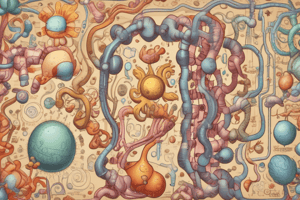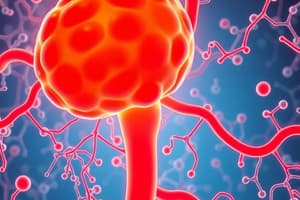Podcast
Questions and Answers
What is the primary function of lipoprotein lipase in relation to exercise?
What is the primary function of lipoprotein lipase in relation to exercise?
- It enhances the transport of glucose into the bloodstream.
- It breaks down plasma triglycerides for fatty acid uptake. (correct)
- It facilitates the uptake of amino acids in muscles.
- It provides energy directly to the brain during strenuous activities.
What role do GLUT4 and FAT/CD36 play during physical activity?
What role do GLUT4 and FAT/CD36 play during physical activity?
- They coordinate the transport of nutrients to ensure enough fuel is available. (correct)
- They are responsible for the synthesis of lipoprotein lipase.
- They inhibit the uptake of glucose and fatty acids.
- They increase the production of plasma triglycerides.
How does electrical stimulation via the sciatic nerve influence transport proteins?
How does electrical stimulation via the sciatic nerve influence transport proteins?
- It enhances the function of fatty acid transport proteins. (correct)
- It decreases the transport efficiency of amino acids.
- It disrupts the coordination of insulin signaling.
- It leads to the breakdown of glycogen stores.
What did the study involving cycling at 60% VO2 max specifically focus on regarding response to exercise?
What did the study involving cycling at 60% VO2 max specifically focus on regarding response to exercise?
What effect does increased total lipoprotein lipase (LPL) in muscle have during exercise?
What effect does increased total lipoprotein lipase (LPL) in muscle have during exercise?
What is the primary function of stored lipids in the body?
What is the primary function of stored lipids in the body?
Which of the following plays a role in the mobilization of lipids from adipose tissue?
Which of the following plays a role in the mobilization of lipids from adipose tissue?
How is fatty acid transport in muscle affected by insulin and exercise?
How is fatty acid transport in muscle affected by insulin and exercise?
What are the possible fates of fatty acids in adipose tissue?
What are the possible fates of fatty acids in adipose tissue?
Which component is primarily responsible for the uptake of fatty acids in muscle?
Which component is primarily responsible for the uptake of fatty acids in muscle?
What is a significant change in lipolysis due to training?
What is a significant change in lipolysis due to training?
Which statements about dietary lipids as a fuel during exercise are correct?
Which statements about dietary lipids as a fuel during exercise are correct?
What role do albumin-bound free fatty acids play in lipid metabolism?
What role do albumin-bound free fatty acids play in lipid metabolism?
What role does carnitine palmitoyl transferase 1 (CPT1) play in fatty acid entry into mitochondria?
What role does carnitine palmitoyl transferase 1 (CPT1) play in fatty acid entry into mitochondria?
Which statement is true regarding lipid utilization during exercise?
Which statement is true regarding lipid utilization during exercise?
What happens to the contribution from fat oxidation in exercise-trained subjects?
What happens to the contribution from fat oxidation in exercise-trained subjects?
What key factor was historically considered rate limiting for fatty acid entry into mitochondria?
What key factor was historically considered rate limiting for fatty acid entry into mitochondria?
Why might carnitine not be necessary as some fat-burning supplements claim?
Why might carnitine not be necessary as some fat-burning supplements claim?
During a low-intensity running session, what is observed regarding plasma free fatty acids (FFA) with aerobic training?
During a low-intensity running session, what is observed regarding plasma free fatty acids (FFA) with aerobic training?
In the context of mitochondrial lipid utilization, what has been a recent area of debate among researchers?
In the context of mitochondrial lipid utilization, what has been a recent area of debate among researchers?
What impact does prolonged aerobic training have on fat oxidation rates at a constant workload?
What impact does prolonged aerobic training have on fat oxidation rates at a constant workload?
What explains the lower circulating free fatty acid (FFA) levels in trained individuals during aerobic exercise?
What explains the lower circulating free fatty acid (FFA) levels in trained individuals during aerobic exercise?
How do trained muscles compensate for lower plasma FFA levels?
How do trained muscles compensate for lower plasma FFA levels?
What physiological adaptation relates to increased fat oxidation with training?
What physiological adaptation relates to increased fat oxidation with training?
What is one paradox associated with intramuscular triglycerides (IMTGs) in endurance-trained athletes?
What is one paradox associated with intramuscular triglycerides (IMTGs) in endurance-trained athletes?
What might explain differences in plasma FFA levels at higher exercise intensities?
What might explain differences in plasma FFA levels at higher exercise intensities?
Which molecules are indicated to interfere with insulin signaling and lead to insulin resistance?
Which molecules are indicated to interfere with insulin signaling and lead to insulin resistance?
What was the observed level of total ceramide in athletes compared to their sedentary counterparts?
What was the observed level of total ceramide in athletes compared to their sedentary counterparts?
In which group was total DAG reported to be lowest?
In which group was total DAG reported to be lowest?
What role does the protein Akt2 play in insulin signaling?
What role does the protein Akt2 play in insulin signaling?
How do ceramides influence the energy production in the presence of fatty acids during insulin signaling?
How do ceramides influence the energy production in the presence of fatty acids during insulin signaling?
What effect do diacylglycerols have on insulin receptor signaling?
What effect do diacylglycerols have on insulin receptor signaling?
What is the relationship between imbalanced fatty acid metabolism and insulin signaling?
What is the relationship between imbalanced fatty acid metabolism and insulin signaling?
What metabolic state is characterized by high levels of ceramides and impaired insulin signaling?
What metabolic state is characterized by high levels of ceramides and impaired insulin signaling?
Flashcards are hidden until you start studying
Study Notes
Lipid Metabolism Sources
- Adipose triacylglycerol (TAG) or triglyceride (TG)
- Intramuscular TAG or TG (IMTG)
- Blood-borne
- Albumin-bound free fatty acids (FFA or FA) from adipose
- TAGs from chylomicrons (intestinal-derived) or VLDL (liver)
Lipids as Fuel
- The body’s main form of stored energy
- Spares carbohydrate reserves
- Cannot be used anaerobically but contributes to high-intensity exercise
Sites of Regulation
- Mobilization from adipose tissue
- Uptake by muscle
- Mitochondrial uptake and oxidation
Mobilization from Adipose Tissue
- Lipolysis is the breakdown of stored triglycerides into free fatty acids (FFA) and glycerol
- Lipolysis is regulated by hormones, including epinephrine (Epi), norepinephrine, and glucagon
- Hormonal sensitivity increases with training, enhancing lipolysis
Muscle Fatty Acid Uptake
- Fatty acid transporter proteins facilitate the uptake of fatty acids into muscle cells
- Key transport proteins include:
- FAT/CD36 (fatty acid translocase)
- FABPpm (fatty acid binding protein)
- FATP1-6 (fatty acid transport family)
FAT/CD36 and Exercise
- Two separate pools of FAT/CD36 translocate in response to insulin and exercise
- Translocation to the plasma membrane and fatty acid uptake are partially additive
- Insulin and contraction stimulate FA transport in an additive manner
Intramuscular Lipid Utilization
- During prolonged exercise, intramuscular lipid utilization increases
- Type II muscle fibers do not break down lipids during exercise, but do during recovery
Mitochondrial Membrane Transport
- Fatty acid entry into the mitochondrion is a complex process
- Requires carnitine palmitoyl transferase 1 (CPT1) and carnitine
- Fatty acids are activated by acyl CoA-synthetase to form FA acyl-CoA
- Fatty acyl CoA is converted to fatty acyl carnitine, which can cross the mitochondrial membrane
- FAT/CD36 may also be present on the inner mitochondrial membrane
Fat Oxidation and Training
- Fat oxidation is increased with training. This includes:
- Increased sensitivity of adipose HSL to epi
- Increased lipoprotein lipase content
- Increased FA transporters at the plasma membrane
- Increased content of beta-oxidation, Krebs cycle, and electron transport chain enzymes
- Increased IMTG content
IMTG and Insulin Sensitivity
- Intramuscular triglycerides (IMTG) are associated with insulin resistance, but this is not always the case in endurance-trained athletes
- Diacylglycerols and ceramides interfere with insulin signaling leading to insulin resistance.
- Athletes have reduced total ceramide levels which may contribute to their insulin sensitivity despite high IMTG content
Studying That Suits You
Use AI to generate personalized quizzes and flashcards to suit your learning preferences.




